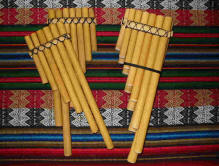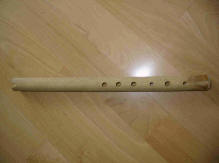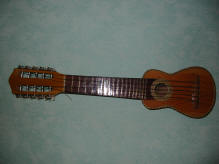In the Andean Indian culture, music is considered as an important social and spiritual event from the daily life, used by groups of people for meeting and expressing their emotions and feelings. One can note that playing music instruments is an activity which is mainly reserved for men (The female musicians from "Bolivia" band are one of the rare exceptions). There is a wide choice of music instruments in Bolivia, which may also vary in shapes and sizes.
Wind Instruments
 Siku (aymara) or
antara (quechua) or zampoņa (spanish): Wind Pipe composed of two
series of bamboo pipes of different lengths traditionally tied together with llama wool strings. The origin of this wind pipe is
from ancient aymara settlements living on the altiplano. Several instruments belong to the siku family, they are named differently
according to their dimensions: e.g. toyo (around 150cm), zanca (75cm),
malta (30cm), and chuli
(15cm). Siku player is called sikuri or zamponero. Each series of pipes constituting the siku may be
used by one or several musicians. A dialogue is established between the iras
(leading musicians playing 6/7 pipe instrument) and the arcas (other musicians following with 7/8
pipe instruments). In Aymara language, the sentense "Jactasina Irpirimpi Arkirimpi" (create, receive and give)
characterize this system based on dialogue between two instruments.
Siku (aymara) or
antara (quechua) or zampoņa (spanish): Wind Pipe composed of two
series of bamboo pipes of different lengths traditionally tied together with llama wool strings. The origin of this wind pipe is
from ancient aymara settlements living on the altiplano. Several instruments belong to the siku family, they are named differently
according to their dimensions: e.g. toyo (around 150cm), zanca (75cm),
malta (30cm), and chuli
(15cm). Siku player is called sikuri or zamponero. Each series of pipes constituting the siku may be
used by one or several musicians. A dialogue is established between the iras
(leading musicians playing 6/7 pipe instrument) and the arcas (other musicians following with 7/8
pipe instruments). In Aymara language, the sentense "Jactasina Irpirimpi Arkirimpi" (create, receive and give)
characterize this system based on dialogue between two instruments.
 Kena (quena):
A quena is a simple flute made of bamboo, which has a round aperture at its end on which comes the lower lip. The Quena flute is 50cm
long and has a diameter of 2 to 3 cm, and comprises 6 frontal holes and a back hole. In the same family of instruments, one finds the
quenacho which is slightly shorter (44cm) and thiner that the quena and comprises 4 frontal holes, a
side hole and a back hole.
Kena (quena):
A quena is a simple flute made of bamboo, which has a round aperture at its end on which comes the lower lip. The Quena flute is 50cm
long and has a diameter of 2 to 3 cm, and comprises 6 frontal holes and a back hole. In the same family of instruments, one finds the
quenacho which is slightly shorter (44cm) and thiner that the quena and comprises 4 frontal holes, a
side hole and a back hole.
Erke (erque) or phututu: Musical instrument cut in a horn of cow. It is originating from Tarija region and is played exclusively between New Year's day and Carnival. In the same family of instruments, one finds the caņa which is a horn of cow prolonged by a wooden tube of 3 meters long, and which is very similar to the large horn instruments traditionally used in the Swiss Alps.
 Tarca: Flute carved in wood,
painted with bright colors, and perforated with 6 frontal holes. Several music instruments belong to the tarcas family. They differ
from their size or their number of side holes.
Tarca: Flute carved in wood,
painted with bright colors, and perforated with 6 frontal holes. Several music instruments belong to the tarcas family. They differ
from their size or their number of side holes.
Ocarina: Wind instrument with a round shape made of terracotta, which can be decorated and painted in multiple ways.
String Instruments
 Charango: Kind of small round
guitar which was introduced after the Spanish conquest in the departments of Potosi and Chuquisaqua. The charango can be manufactured
in a wood hull or in a carapace of quirquincho (armadillo). The shape and dimension of the case of resonance confer a very particular
acute sonority to this instrument.
Charango: Kind of small round
guitar which was introduced after the Spanish conquest in the departments of Potosi and Chuquisaqua. The charango can be manufactured
in a wood hull or in a carapace of quirquincho (armadillo). The shape and dimension of the case of resonance confer a very particular
acute sonority to this instrument.
Drums
Huancara (wankara): Round shape drums, with two faces made of goatskins firmly attached one to the other by a series of ropes. Huancaras are usually used in combination with sikus.
Bombo: Circular drum manufactured in a hollow tree trunk, with two faces made of animal skins and firmly attached one to the other by a series of ropes.
Chajcha: Chain made of several goat or pig nails which hit each others and produce a sound at a rhythm given by the movements of hands or foots.
Palo de lluvia: Trunk of desiccated cactus which has been hermetically closed after being filled with a handle of sand grains. The reversal of the tube upwards causes the fall of the sand grains which are accompanied by a light rustle evoking the rain drops.